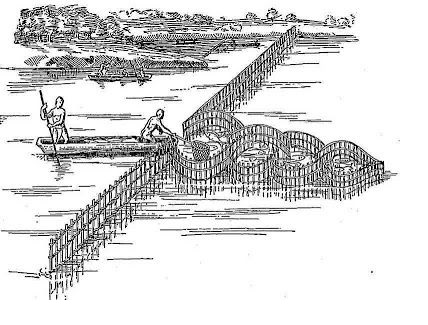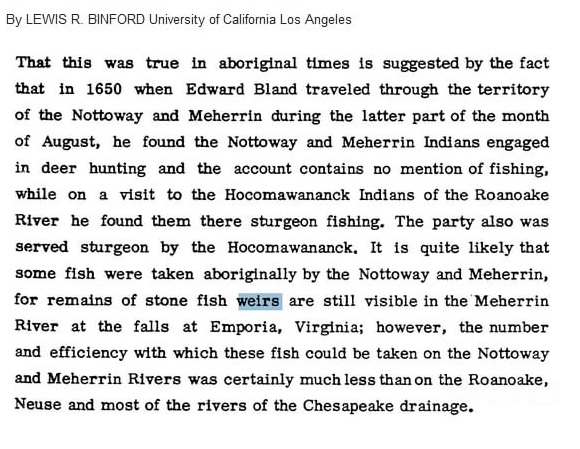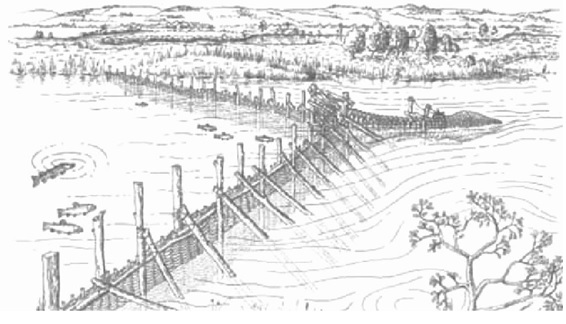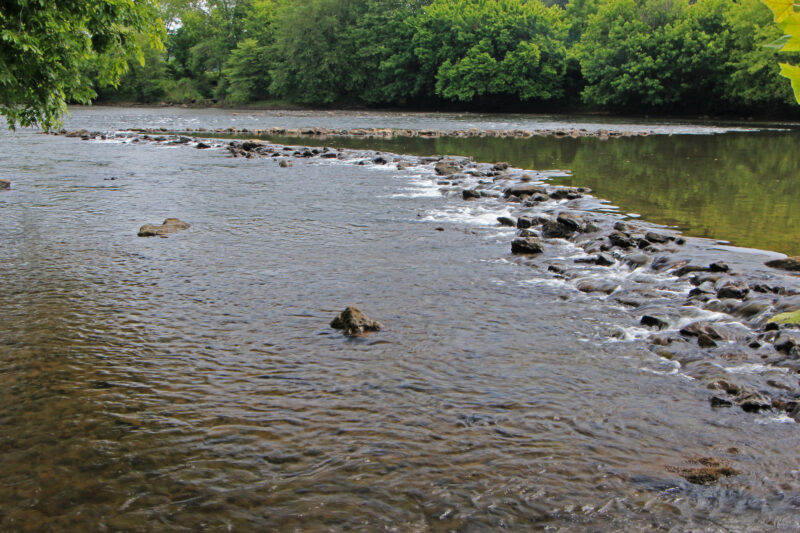Fishing Weirs in Virginia and North Carolina.
For the Meherrin, life in early spring (March and April) revolved around fish runs along the Meherrin River. Weirs were used to catch anadromous sturgeon, rockfish (striped bass), and members of the herring family (alewife, shad, thread herring).
These fishing weirs also served as gathering places for the community. During the fishing season, family members and community members would come together to work at the weirs, creating a social and cooperative atmosphere. They would celebrate successful catches and engage in cultural activities, reinforcing their bond with nature and their traditions.
The use of fishing weirs played a significant role in the cultural, social, and economic aspects of Meherrin lives. It allowed them to sustain their communities, and trade with neighboring tribes.
Over time, as European colonization took hold in the region, the traditional practices of the Meherrin, including fishing weirs, faced various challenges and disruptions. Changes in land use, encroachment, and shifts in fishing practices gradually impacted the use of fishing weirs among the Meherrin.

Archaeological evidence suggests that winter hunting quarters and spring fish camps were located upstream near the fall line, while spring through fall agricultural and gathering activities were dispersed along the floodplains downstream.

Seasonal shifts up towards the sparsely populated Piedmont would make sense in terms of subsistence strategy because of larger deer herds and easier weir fishing (facilitated by the narrowing of the rivers and availability of large cobbles).
The Meherrin made stone fish weirs that are still visible in the Meherrin River at the falls at Emporia, Virginia.

Prehistoric Fishweirs in Eastern North America. Master’s Thesis by Allen Lutins.
Virginia Fishing Weirs
Ethnographic and contemporary accounts of weirs are perhaps more common for Virginia than for any other state. Trigger (1978:258,284) mentions that the Algonquians in this state employed weirs at the time of European contact, as did Iroqouian tribes on the Virginia/North Carolina border. He is unclear about the location or type of weirs utilized by the Algonquians, but does note that Iroquoian groups utilized “reed” weirs. Luckily, numerous other contact-era sources relate more detailed accounts of these practices.
Accounts of weir use in Virginia date back to the 1580’s. M. Thomas Hariot and Ralph Lane observed the use of “reed” weirs at the time, but failed to describe such details as layout, location and method of employment (Hakluyt 1907:183). However, the engravings which accompanied Hariot’s book (published in 1588) serve to ameliorate some of these shortcomings. The engravings, prepared by Theodore DeBry from John White’s watercolors (painted between 1585 and 1586, and now lost) depict stake weirs on the coast near Roanoke. One of the weirs appears to be a simple reed fence (Figure 4), while another consists of interconnected enclosures that open one into the next (Figures 5 and 6) (Hariot 1588). One century later, these same weirs were still in use, as were other types, judging by the following account (Beverley 1705:148):
The larger Fish, that kept in deeper Water, they were put to a little more Difficulty to take; But for these they made Weyrs; that is, a Hedge of small riv’d Sticks, or Reeds, of the Thickness of a Man’s Finger, these they wove together in a Row, with Straps of Green Oak, or other tough Wood, so close that the small Fish cou’d not pass through…(they) were contrived so, that the Fish could easily find their Passage into those Cods (pockets)…but not see their Way out again, when they were in; Thus if they offered to pass through, they were taken.

Sometimes they made a Hedge as this, quite a-cross a Creek at High-Water, and at Low would go into the Run, so contracted into a narrow Compass, and take out what Fish they pleased.
At the Falls of the Rivers, where the Water is shallow, and the Current b, the Indians use another kind of Weir, thus made: They make a Dam of loose Stone, where of there is plenty at hand, quite across the River, leaving One, Two, or more Spaces or Trunnels, for the Water to pass thro’; at the Mouth of which they set a Pot or Reeds, wove in Form of a Cone, whose Base is about Three Foot, and in perpendicular Ten, into which the Swiftness of the Current carries the Fish, and wedges them so fast, that they cannot possibly return.
In this description, Beverley describes three distinct types of weirs in use. The first consists of a stake trap into which fish simply wandered and were ensnared; this appears to be of the `labyrinthine’ variety. The second is also a stake weir, but is a simpler tidal trap. The third is a stone weir on a river.
No stake (“reed”) traps are known today from Virginia; indeed, there are no extant tidal traps anywhere along the Atlantic coast (Larson 1980:119). However, accounts of stone weirs in Virginia’s rivers abound. Unfortunately, it is often difficult to distinguish prehistoric from historic weirs. Strandberg and Tomlinson (1969:319) described a number of stone weirs in this century in the James and Shenandoah Rivers. At least two of the James River weirs, in Richmond, are very likely of prehistoric origin, judging by their inclusion in a seventeenth century manuscript. They are “W”-shaped with the points oriented downstream (Bushnell 1930:8). In addition, there are mid-18th century references to a stone weir on the Otter River in Bedford County (northwest of Altavista) (Gravely n.d.).
Stone weirs are also known from the Rappahannock River (above Fredericksburg) and the Rapidan River (at “Skinkel’s Ford”) (Bushnell 1935). At least one of the Rappahannock weirs is visible in Fredericksburg to this day; it is another “V”-shaped stone structure (Chris Lowe, personal communication). There is also a stone weir (“V”-shaped) visible in the Smith River in Martinsville (Gravely 1973). There are reports of historic Native American weirs on the Rappahannock, but their design is unlike any other known prehistoric weirs, and they are confirmed to be of historic
North Carolina Fishing Weirs
A large number of stone weirs are known from North Carolina; unfortunately, none have ever been studied nor adequately mapped. Peck (1977:5) alleges that over one hundred weirs (certainly not all prehistoric) are said to be visible from the air in the Rocky River, but he fails to cite scholarly sources attesting to this fact. Better evidence exists for other, isolated weirs. William Oliver (personal communication) affirms the existence of a “V”-shaped stone weir at the Town Creek Indian Mound (31 Mg 3) in Montgomery County, another stone weir (no description provided) at the Trestle Site (31 An 19), and other stone weirs in the Pee Dee River in Montgomery, Richmond, Stanly and Anson counties. In a voyage down the Yadkin and Pee Dee Rivers in the 1920’s, Douglas Rights (1929) encountered a dozen “V”- and “W”-shaped stone weirs. He claims (Rights 1929:18) that they are of prehistoric origin based on the proximity of “Indian village sites.” Peck (1977) established that stone weirs on the Pee Dee River consist of four distinct types, including “V”-shaped with a simple opening, “V”-shaped with a “parallel” opening, “W”-shaped, and “Multiple V”-shaped. All of these types are described as having openings at the apexes.
Ethnographic accounts of weir use in North Carolina are rare. Contact-era sources mention that Algonquian tribes in this state used “reed” weirs (Trigger 1978:273). In his diary, Ralph Lane discusses the use of weirs (of an unspecified type) on the coast in March of 1586 (Larson 1980:121).

Stone Fishing Weir
